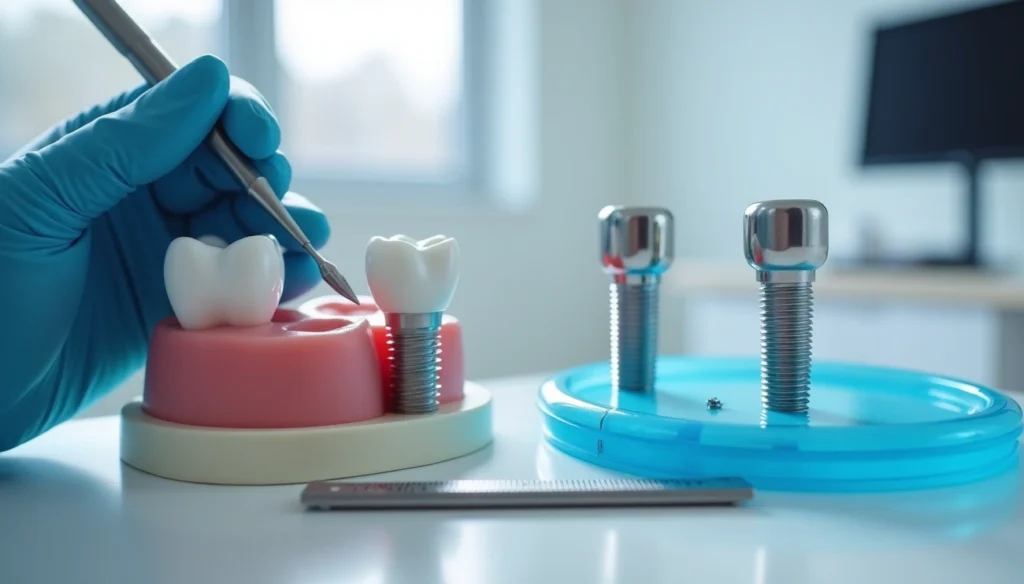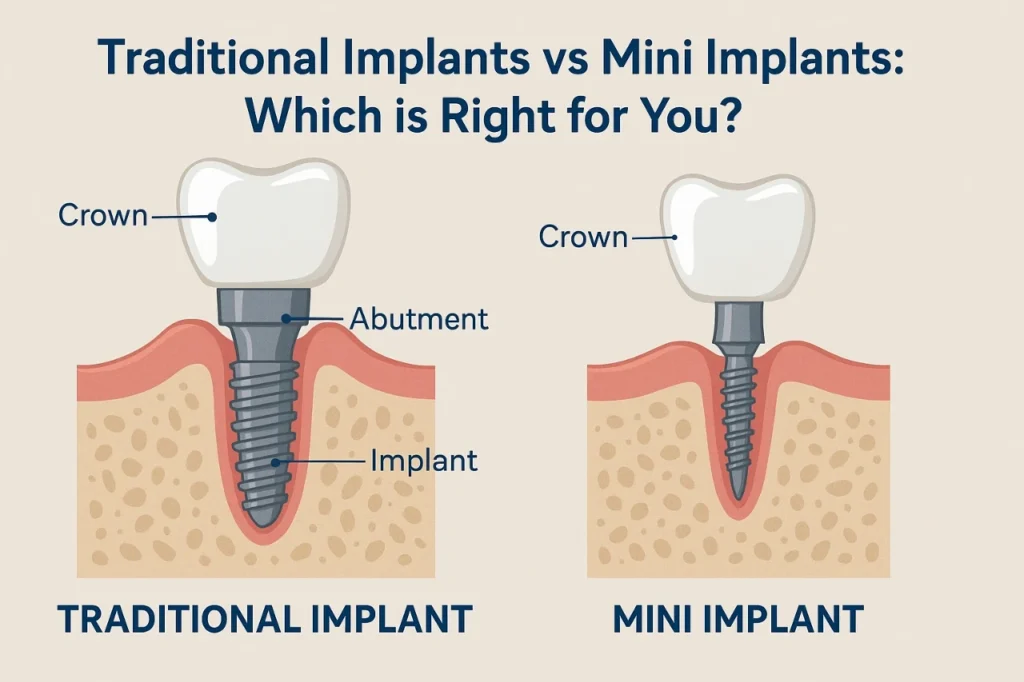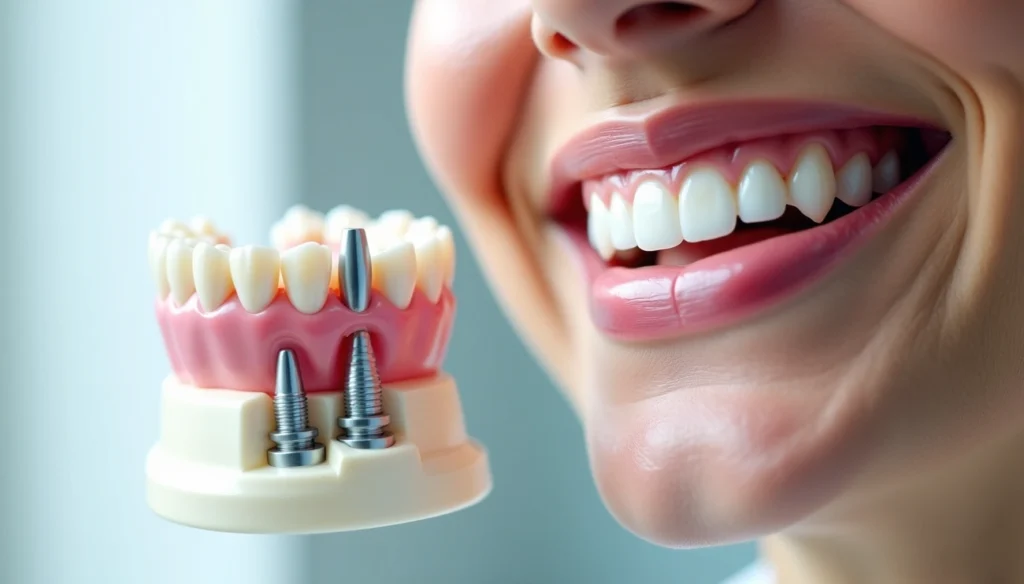
The choice between mini dental implants and traditional implants remains one of the most important decisions for 35 million Americans who have lost their upper or lower teeth, or both. Mini dental implants emerged as an alternative to conventional dental implants in the late 1970s, but dentists didn’t start using them until the 1990s. These implants come with unique differences in size, structure, and how they’re used.
The size sets these two types of implants apart clearly. Mini dental implants are solid, one-piece screws that measure less than 3mm in diameter. Traditional implants, however, come in two pieces and measure between 3.25 to 5 millimeters across. The cost difference between these options stands out too. You’ll pay between $500 to $1,500 for a single mini dental implant. Regular implants cost nowhere near that amount – they range from $3,000 to $6,000 per tooth. Mini dental implants also let patients heal faster. Most people recover within days or weeks, while traditional implants need more time.
This piece dives deep into what makes mini dental implants different from regular ones. We’ll look at their structure, surgical methods, healing times, and costs. Understanding these options’ strengths and limits helps you pick what works best for your dental needs, budget, and long-term oral health goals.
What Makes Mini and Traditional Implants Different?
The size, structure, and procedure create big differences between mini dental implants and traditional implants. These differences affect treatment results and patient experience. Patients need to know these differences to make better decisions about their dental restoration options.
Size and structure comparison
The main difference between mini and traditional implants lies in their diameter. Mini implants are less than 3mm wide. This makes them about half as wide as conventional implants that range from 3.4mm to 5.8mm. Both types are the same length though.
These options have very different designs:
- Mini implants come as one solid screw with a ball-shaped end that sticks out from the jawbone
- Traditional implants have multiple parts—a post goes into the bone and a separate abutment connects to the restoration
This design difference makes mini implants simpler but they might not work for everything. Mini implants’ smaller size means they just need less bone density. This makes them perfect for patients who have jawbone loss and would otherwise need bone grafts.
Surgical procedure differences
Each implant type uses a different placement process. Mini dental implants use a gentler approach with a small pilot hole. The process doesn’t cut much gum tissue. Dentists can usually finish everything in one visit.
Traditional implants take more work to place. Dentists must make bigger openings in the gums to see the jawbone. They also drill wider holes for the larger implant posts. Patients usually need several appointments over many months.
Healing and integration time
Recovery works differently for each option. Mini dental implants heal faster—the gums usually heal within 2-5 days. Patients can often get their new teeth during the same visit because these smaller implants can handle immediate use.
Traditional implants take longer to heal. The bone needs to fuse with the implant—a process called osseointegration. This usually takes 3-6 months before dentists can attach permanent teeth. Patients who want quick results will need patience with this option.
Pros and Cons of Mini Dental Implants

Image Source: Today’s Dental Grand Prairie
Patients who want to replace missing teeth need to know both the benefits and limitations of mini dental implants before making their choice.
Advantages: less invasive, faster recovery, lower cost
Mini dental implants give patients several compelling benefits:
- Minimally invasive procedure: Their smaller size needs no extensive gum cutting or complex flap surgery. This means less trauma to oral tissues.
- Remarkably faster healing: Traditional implants need 3-6 months to heal. Mini implants heal completely within 3-4 weeks. Patients can return to their normal activities in just 1-2 days.
- Budget-friendly: Each mini dental implant costs about $1,000 compared to traditional implants at $2,450. This makes them half the price of conventional options.
- No bone grafting required: The smaller diameter eliminates bone grafting in many cases. This makes them ideal for patients who lack sufficient jawbone density.
- Immediate loading capability: Most mini implants can support replacement teeth right after placement. This restores function and esthetics immediately.
Disadvantages: limited durability, not ideal for all cases
Mini dental implants come with some significant limitations:
Limited longevity: These implants last 6-9 years while traditional implants work well for 15+ years. Patients need more frequent replacements.
Reduced stability for certain applications: The smaller diameter makes them unsuitable for molar replacement or patients with strong bite forces.
Higher failure rate: These implants show a 10-20% failure rate over 5 years. This happens because they depend on mechanical retention instead of true jawbone integration.
Health restrictions: Patients with diabetes, vascular disease, hemophilia, bone disease, or periodontitis should avoid these implants.
Maintenance requirements: Daily care matches natural teeth. However, denture abutment O-rings need yearly replacement.
Common misconceptions about mini implants
People often misunderstand several aspects of mini dental implants:
Mini implants cannot match traditional implants’ strength, especially in back teeth.
Many dentists designed these implants as temporary solutions, though marketing often presents them as permanent fixes.
The cost savings might be less than expected. Patients often need 4-6 mini implants to do the job of 1-2 traditional ones.
Local anesthesia remains necessary even though the procedure involves less invasion.
Mini implants do not fully integrate with bone tissue like traditional implants.
Pros and Cons of Traditional Dental Implants
Traditional dental implants are the gold standard in tooth replacement technology. They come with clear benefits and drawbacks that patients need to carefully assess.
Advantages: long-term stability, better for high bite force
Traditional dental implants stand out in several vital areas:
- Superior longevity – These implants can last decades or maybe even a lifetime with good care
- Exceptional stability – The osseointegration process creates such a strong bond that the implant becomes part of your skeletal structure
- Higher success rates – Studies show success rates that exceed 95% for single-unit restorations
- Improved bite force capacity – Traditional implants handle natural chewing forces of 150-200 pounds per square inch
- Bone preservation – They work like natural roots to stimulate the jawbone and prevent deterioration
Disadvantages: higher cost, longer healing time
Traditional implants do come with some challenges:
The original cost ranges from $1,000 to $3,000 per implant, and this is a big deal as it means that they cost more upfront than other options. You’ll need multiple appointments spread across several months. The healing takes 3-6 months while the implant fuses with your jawbone. The surgical process needs incisions, flap creation, and bone drilling.
When traditional implants are not recommended
Traditional implants aren’t right for everyone, especially when you have:
- Recent heart attack or stroke
- Immunosuppression or immune disorders
- Active cancer treatment
- Uncontrolled diabetes
- Patients under 16-18 years
- Pregnancy
Cost, Longevity, and Suitability: Making the Right Choice
Choosing between mini dental implants and traditional implants needs a thorough look at costs, expected lifespan, and your specific needs.
Cost comparison: mini vs traditional implants
The costs tell an interesting story. Mini dental implants cost $500-$1,500 per implant, which is nowhere near the price of traditional implants at $3,000-$6,000 per tooth. A full-mouth solution with mini implants to support lower dentures runs about $2,000-$5,000. Traditional implants for the same purpose could set you back $12,000-$30,000.
Longevity and maintenance needs
Both types of implants connect directly to your jawbone through osseointegration. Traditional implants can last 25+ years or maybe even a lifetime with proper care. Mini implants generally serve you well for 10-15 years. Your daily routine should include brushing, flossing, and regular professional cleanings.
Who is a good candidate for each type?
Mini implants work best for patients who have:
- Limited bone density
- A need for simpler procedures
- Budget restrictions
Traditional implants suit patients with:
- Healthy jawbone structure
- Molar or premolar replacements
- Long-term durability needs
Mini implants vs regular implants for dentures
Mini implants shine at stabilizing dentures. The procedure takes fewer surgical steps. Their compact size often eliminates the need for bone grafting, and patients can use their dentures right away.
Mini implants vs traditional implants for single tooth replacement
Mini implants prove effective for smaller teeth like incisors. Traditional implants offer better strength for your back teeth where pressure is highest.
Conclusion
The choice between mini dental implants and traditional options ended up being based on your situation, budget, and long-term oral health goals. Mini implants give you clear advantages if you want faster results, less invasive procedures, and lower upfront costs. Their smaller size works well for patients who lack sufficient bone density and want to skip bone grafting. Traditional implants still stand as the gold standard for longevity and stability, especially when you have posterior teeth that face heavy chewing forces.
You should think over several key factors before deciding. Your budget comes first – mini implants cost substantially less upfront, but their shorter lifespan might mean replacements that offset any savings down the road. Your medical history matters too, since conditions like diabetes or bone disease could make mini implants a poor fit. Time expectations play a role, as traditional implants need months to heal while mini options let you use them right away.
A qualified dental professional’s guidance proves crucial for this big decision. Most dentists suggest traditional implants for younger patients or molar replacements, while mini implants work better to stabilize dentures or replace smaller teeth. Patients with good jawbone structure usually do better with traditional implants. Mini implants are available without grafting procedures for those who’ve lost bone mass.
Technology keeps advancing and improving both implant options. Traditional implants show higher success rates and last longer, but mini implants are a great way to get results in specific cases where cost, invasiveness, and immediate results matter most. Whatever you choose, both options will boost your quality of life compared to removable dentures or gaps in your smile.
FAQs
Q1. How do mini dental implants compare to traditional implants in terms of cost? Mini dental implants typically cost between $500 to $1,500 per implant, which is about half the price of traditional implants that range from $3,000 to $6,000 per tooth. This significant cost difference makes mini implants a more budget-friendly option for many patients.
Q2. What is the expected lifespan of mini dental implants versus traditional implants? Traditional dental implants often last 25 years or more, potentially even a lifetime with proper care. In contrast, mini dental implants generally have a shorter lifespan of about 10-15 years. This difference in longevity is an important factor to consider when choosing between the two options.
Q3. Are mini dental implants suitable for all tooth replacement needs? Mini dental implants are not ideal for all cases. They work well for smaller teeth like incisors and for stabilizing dentures. However, traditional implants are better suited for replacing molars or premolars, especially in patients with strong bite forces. The choice depends on the specific dental needs of the patient.
Q4. How does the healing process differ between mini and traditional dental implants? Mini dental implants offer a significantly faster healing process, with patients typically recovering within days or weeks. Traditional implants, on the other hand, require a longer healing period of 3-6 months for proper osseointegration. This difference in healing time can be a crucial factor for patients seeking quicker results.
Q5. What is the “3/2 rule” for dental implants? The 3/2 rule is a guideline used to determine the number of implants needed to support replacement teeth. It suggests using at least two implants for every three missing teeth. For example, if a patient is missing six teeth, four implants might be recommended to ensure a strong and secure structure.

![The Real Difference Between Zirconia and Titanium Dental Implants [2025 Guide]](https://dentalimplantinsights.com/wp-content/uploads/2025/08/The-Real-Difference-Between-Zirconia-and-Titanium-Dental-Implants-2025-Guide-1024x682.webp)
